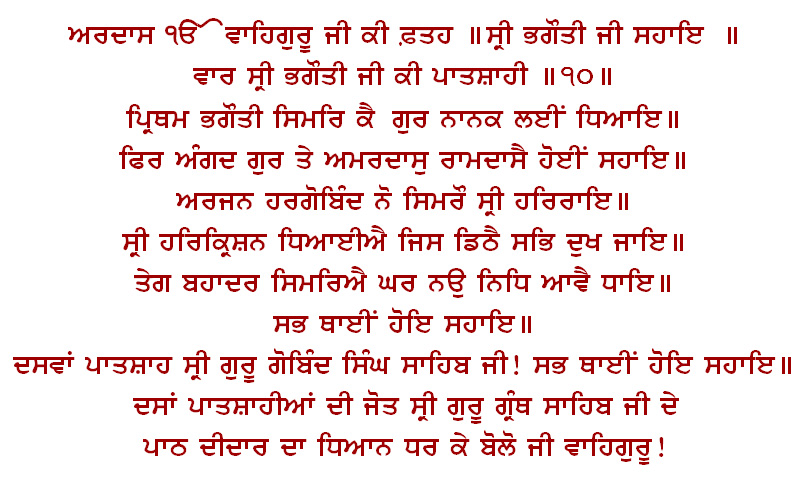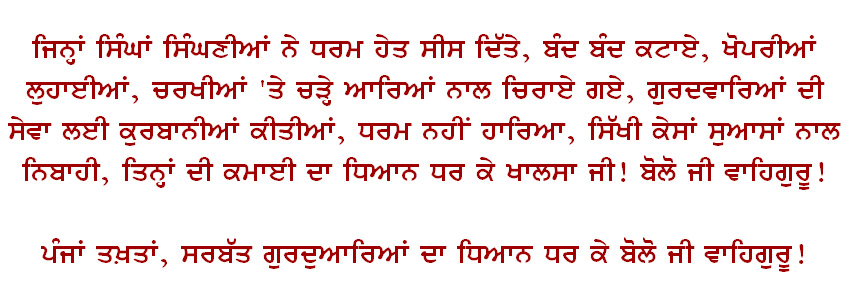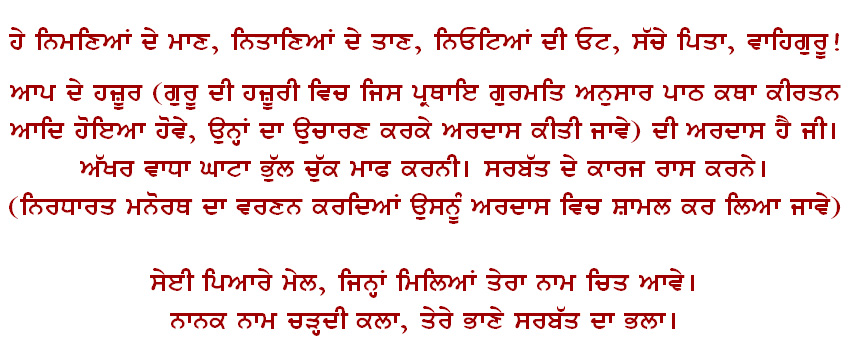 |
|
| |
|
| Subject Expert |
: |
|
Dr. Paramvir Singh
Associate Professor
Prof. Harbans Singh Encyclopedia of Sikhism
Punjabi University, Patiala |
| Audio |
: |
|
Dr. Jagir Singh |
| Photographs |
: |
|
S. Tejpartap Singh Sandhu |
| Translation |
: |
|
Ms. Narinderjit Kaur |
| Voice Over |
: |
|
Ms. Raman Chahal |
|
|
Ardas has a fundamental significance in Sikh religion. Ardas means appeal, prayer, entreaty etc. In Gurbani has a fundamental significance in Sikh religion. Ardas means appeal, prayer, entreaty etc. In Gurbani , words like ‘Arz’ , words like ‘Arz’ ‘Benti’ ‘Benti’ ‘binaoo’ ‘binaoo’ ‘Jachna.’ ‘Jachna.’ are synonymous with Ardas. To perform the Ardas at individual as well as collective congregational level is one of the essential principles of Sikhism. Whenever the Sikhs perform any religious ceremony, or any family, public or collective function, they perform Ardas in the beginning as well as at the conclusion of it. Etymologically, the word originated from the Persian word ‘Arzdashat’ are synonymous with Ardas. To perform the Ardas at individual as well as collective congregational level is one of the essential principles of Sikhism. Whenever the Sikhs perform any religious ceremony, or any family, public or collective function, they perform Ardas in the beginning as well as at the conclusion of it. Etymologically, the word originated from the Persian word ‘Arzdashat’ which means a petition, a reminder or an address to a superior authority. which means a petition, a reminder or an address to a superior authority.
The Sikh Ardas is rendered to God Almighty as a supplication standing in front of Guru Granth Sahib . And if Guru Granth Sahib is not there, even then it can be performed by standing in a similarly reverential posture, keeping in mind the omnipresence of the God. No written version of Ardas is found in Guru Granth Sahib. This is an outcome of centuries-old feelings and emotions of a humble community for the God Almighty. Whenever the community has faced any difficult situation at any stage in its history, or whenever it has thought of expressing its gratitude towards God, it has done so through the recitation of Shabads or Holy Hymns. And whenever, the whole Sangat . And if Guru Granth Sahib is not there, even then it can be performed by standing in a similarly reverential posture, keeping in mind the omnipresence of the God. No written version of Ardas is found in Guru Granth Sahib. This is an outcome of centuries-old feelings and emotions of a humble community for the God Almighty. Whenever the community has faced any difficult situation at any stage in its history, or whenever it has thought of expressing its gratitude towards God, it has done so through the recitation of Shabads or Holy Hymns. And whenever, the whole Sangat or congregation has joined the Ardas for the community (it can be all humanity as well), its spiritual expression has taken the form of Ardas. or congregation has joined the Ardas for the community (it can be all humanity as well), its spiritual expression has taken the form of Ardas.
According to the Sikh tradition, the person who performs Ardas is called ‘Ardasia’ . In the beginning, the Ardasia recites the Shalokas or Hymns from the Gurbani pertaining to Ardas. For example: . In the beginning, the Ardasia recites the Shalokas or Hymns from the Gurbani pertaining to Ardas. For example:
|
| |
ਆਪੇ ਜਾਣੈ ਕਰੇ ਆਪਿ ਆਪੇ ਆਣੈ ਰਾਸਿ || |
aapay jaanai karay aap aapay aanai raas.
(The Lord Himself knows, Himself does and Himself does it right.) |
| |
| ਤਿਸੈ ਅਗੈ ਨਾਨਕਾ ਖਲਿਇ ਕੀਚੈ ਅਰਦਾਸਿ ||1|| |
tisai agai naankaa khali-ay keechai ardaas. ||1||
(So, stand before Him and make a supplication, O Nanak.) |
(Sri Guru Granth Sahib, P. 1093) |
| |
ਸੁਖਦਾਤਾ ਭੈ ਭੰਜਨੋ ਤਿਸੁ ਆਗੈ ਕਰਿ ਅਰਦਾਸਿ ||  |
sukh-daata bhai bhanjno tis aagai kar ardaas.
(Make supplication before Him who is the bestower of bliss and the destroyer of dread.) |
|
| ਮਿਹਰ ਕਰੇ ਜਿਸੁ ਮਿਹਰਵਾਨੁ ਤਾਂ ਕਾਰਜੁ ਆਵੈ ਰਾਸਿ |
mihar karay jis miharvaan taaN kaaraj aavai raas. ||3||
(He, to whom the Merciful Master shows his mercy, has his affairs, adjusted forth with.) |
| (Sri Guru Granth Sahib, P. 44) |
ਦੁਇ ਕਰ ਜੋੜਿ ਕਰਉ ਅਰਦਾਸਿ ||  |
du-ay kar jor kara-o ardaas.
(Joining both my hands I make supplication before the Lord.) |
| |
| ਤੁਧੁ ਭਾਵੈ ਤਾ ਆਣਹਿ ਰਾਸਿ || |
tudh bhaavai taa aaneh raas.
(If Thou willest, then alone Thou embellishest me.) |
(Sri Guru Granth Sahib, P. 737) |
|
According to the contemporary tradition, before Ardas, the following Shabad from the ‘Sukhmani Sahib’ of the fifth Guru, Guru Arjan Dev of the fifth Guru, Guru Arjan Dev ji, is usually recited: ji, is usually recited: |
| |
ਤੂ ਠਾਕੁਰੁ ਤੁਮ ਪਹਿ ਅਰਦਾਸਿ ||  |
too thaakur tum peh ardaas.
(Thou art the Lord, I make this supplication unto Thee.) |
| |
| ਜੀਉ ਪਿੰਡੁ ਸਭੁ ਤੇਰੀ ਰਾਸਿ || |
jee-o pind sabh tayree raas.
(My soul and body are all Thine capital.) |
| |
| ਤੁਮ ਮਾਤ ਪਿਤਾ ਹਮ ਬਾਰਿਕ ਤੇਰੇ || |
tum maat pitaa ham baarik tayray.
(Thou art Mother and Father and we are Thine children.) |
| |
| ਤੁਮਰੀ ਕ੍ਰਿਪਾ ਮਹਿ ਸੂਖ ਘਨੇਰੇ || |
tumree kirpaa meh sookh ghanayray.
(In Thine grace lie many comforts.) |
| |
| ਕੋਇ ਨ ਜਾਨੈ ਤੁਮਰਾ ਅੰਤੁ || |
ko-ay na jaanai tumraa ant.
(No one knows Thy limit.) |
| |
| ਊਚੇ ਤੇ ਊਚਾ ਭਗਵੰਤ || |
oochay tay oochaa bhagvant.
(Thou, O Wealthy Lord, art the Highest of the high.) |
| |
| ਸਗਲ ਸਮਗ੍ਰੀ ਤੁਮਰੈ ਸੂਤ੍ਰਿ ਧਾਰੀ || |
sagal samagree tumrai sutir Dhaaree.
(The entire creation is strung on Thy thread.) |
| |
| ਤੁਮ ਤੇ ਹੋਇ ਸੁ ਆਗਿਆਕਾਰੀ || |
tum tay ho-ay so aagi-aakaaree.
(What has sprung from Thee, that is in Thy command.) |
| |
| ਤੁਮਰੀ ਗਤਿ ਮਿਤਿ ਤੁਮ ਹੀ ਜਾਨੀ || |
tumree gat mit tum hee jaanee.
(Thine condition and extent, Thou alone knowest.) |
| |
| ਨਾਨਕ ਦਾਸ ਸਦਾ ਕੁਰਬਾਨੀ ||8||4|| |
naanak daas sadaa kurbaanee. ||8||4||
(Nanak, a slave of Thine is ever a sacrifice unto Thee.) |
(Sri Guru Granth Sahib, P. 268) |
|
|
|
 |
| |
Broadly, the Ardas consists of three parts: |
|
| |
|
|
 |
|
| |
|
|
| |
 |
| |
Ardaas
Ik O-a`nkaar Waaheguroo Ji Ki Fateh
Sri Bhagautee Jee Sahaa-e
Vaar Sri Bhagauti Ji ki Paatshaahi Daswee`n
Pritham Bhagauti simar kai,
Gur Naanak la-ee dhia-e
Phir A`ngad Gur te Amar Daas,
Raam Daasai ho-e sahaa-e.
Arjan Har Gobind noòn Simro Sri Har Raai.
Sri Har Krishan dhia-ee-ai Jis dithhai sab dukh jaa-e.
Teg Bahadar simre-ai, Ghar nau-nidh aavai dhaa-e.
Sabh thaa-ee`n ho-e sahaa-e.
Dasva`n paatshhah sri Guroo Gobind Singh ji Mahaaraaj, Sabh thaa-ee`n ho-e sahaa-e
Dasa`n paatshaahee-aa`n di jot Sri Guroo Gra`nth saaheb ji de paathh deedaar daa dhian dhar ke bolo ji Waaheguroo. |
|
| |
(One Absolute Manifest; victory belongeth to the Wondrous Destroyer of darkness. May the might of the All-powerful help!
Ode to his might by the tenth lord.
Having first thought of the Almighty's prowess, let us think of Guru Nanak. Then of Guru Angad, Amardars and Ramdas - may they be our rescuers! Remember, then Arjan, Harigobind and Harirai. Meditate then on revered Hari Krishan on seeing whom all suffering vanishes. Think then of Tegh Bahadar, rememberance of whom brings all nine treasures. He comes to rescue everywhere. Then of the tenth lord, revered Guru Gobind Singh, who comes to rescue everywhere. The embodiment of the light of all ten sovereign lordships, the Guru Granth - think of the view and reading of it and say, "Waheguru (Wondrous Destroyer of darkness)".) |
|
In the first part, the Ardasia Sikh recites, verbatim, the above mentioned Shabad ‘Vaar Shri Bhagoti ji ki’ of Guru Gobind Singh ji. In this hymn God Almighty and the first nine Gurus are invoked. The first promise that the community has made in this is that the names of Guru Gobind Singh ji and Guru Granth Sahib, which was ordained by the Guru as the manifestation of the Guru after him, have been included in it. ji and Guru Granth Sahib, which was ordained by the Guru as the manifestation of the Guru after him, have been included in it.
|
| |
|
|
| |
|
|
|
| |
|
|
| |
 |
 |
 |
 |
| |
Pa`nja`n Piaria`n
Chauha`n Sahibzaadia`n
Chaalia`n Muktia`n,
Hathhi-a`n, Japee-a`n, Tapee-a`n,
jinha`n Naam japia,
Wa`nd Chhakia, Deg chalaa-ee,
Teg Waahi, Dekh ke an-dithh keeta,
tinha piaria`n sachiaria`n de kamaa-ee da dhian dhar ke khaalsa ji bolo ji Waaheguroo.
Jinna`n Singha`n Singhnee-a`n ne dharm het sees ditte,
Ba`nd ba`nd kattaa-e,
khopree-a`n lohaa-ee-a`n,
charkhia`n te charhe,
Aare-a`n naal chiraa-e ga-e,
gurdwaria`n di sewa la-ee kurbaania`n keetia`n, dharm nahi`n haaria,
Sikhi kesa`n suaasa`n naal nibhaahi, tinha di kamma-ee da dhian dhar ke,
Khaalsa ji bolo ji Waaheguroo.
Pa`nja`n Takhta`n sarbat gurdwaria`n da dhian dhar ke bolo ji Waheguroo.
Prithme sarbat khaalsa ji ki Ardaas hai ji,
sarbat khaalsa ji ko
Waheguroo, Waaheguroo, Waaheguroo chit aavai,
chit aavan ka sadka sarab sukh hove jaha`n jaha`n khaalsa ji sahib,
taha`n taha`n rachhia rai-it,
deg teg fateh, bird ki paij, pa`nth ki jeet, sri sahib ji sahaa-e, Khaalsa ji ke bol baale, bolo ji Waaheguroo.
Sikhan noon`n sikhi daan, kes daan, rehat daan, bibek daan, visaah daan, bharosa daan, daanan sir-daan Naam-daan,
Sri Amritsar ji de ishnaan,
chaukia`n jha`nde bunge jugo-jug atal,
Dharm ka jaikar, bolo ji Waaheguroo.
Sikha`n da man neeva`n mat uchi, mat ka raakha aap Waaheguroo.
He Akaal-purkh apne pa`nth de sada sahaa-ee daataar jio, Sri Nankaana Sahib te hor gurdwaria`n gurdhaama`n de, jinha`n to`n pa`nth noon vichho-ria ge-a hai, khulhe darshan deedar te sewa-sambhaal da daan khaalsa ji noo`n bakhsho. |
|
| |
(Meditating on the achievement of the dear and truthful ones, including the five beloved ones, the four sons of the tenth Guru, forty liberated ones, steadfast ones, constant repeaters of the Divine Name, those given to assiduous devotion, those who repeated the Nam, shared their fare with others, ran free kitchen, wielded the sword and everlooked faults and shortcomings, say "Waheguru", O Khalsa.
Meditating on the achievement of the male and female members of the Khalsa who laid down their lives in the cause of dharma (religion and righteousness), got their bodies dismembered bit by bit, got their skulls sawn off, got mounted on spiked wheels, got their bodies sawn, made sacrifices in the service of the shrines (gurduwaras), did not betray their faith, sustained their adherence to the Sikh faith with sacred unshorn hair uptill their last breath, say, "Wondrous Destroyer of darkness", O Khalsa.
Now it is the prayer of the whole Khalsa. May the conscience of the whole Khalsa be informed by Waheguru, Waheguru, Waheguru and, in consequences of such remembrance, may total well-being obtain. Wherever there are communities of the Khalsa, may there be Divine protection and grace, the ascendance of the supply of needs and of the holy sword protection of the tradition of grace, victory of the Panth, the succour of the holy sword, ascendance of the Khalsa. Say, O Khalsa, "Wondrous Destroyer of darkness."
Unto the Sikhs the gifts of the Sikh faith, the gift of the untrimmed hair, the gift of the discipline of their faith, the gift of sense of discrimination, the gift of trust, the gift of confidence, above all, the gift of meditation on the Divine and bath in the Amritsar (holy tank at Amritsar). May hymns-singing missionary parties, the flags, the hostels, abide from age to age. May righteousness reign supreme. Say, "Wondrous Destroyer of darkness."
May the Khalsa be imbued with humility and high wisdom! May Waheguru guard its understanding!
O Immortal Being, eternal helper of Thy Panth, benevolent Lord bestow on the Khalsa the beneficence of unobstructed visit to and free management of Nankana Sahib and other shrines and places of the Guru from which the Panth has been separated.) |
| |
In the above mentioned second part of the Ardas, the fortitude and feats of sacrifices of the Sikhs are remembered; and in this, the whole of Sikh history that goes beyond time and space, is covered. |
| |
|
|
| |
|
|
|
| |
|
|
| |
 |
| |
He nimaania`n de maan, nitaanian de taan, ne-otea`n di ot, sache pita Waheguroo ji aap-de hazoor.............. ardaas hai ji. (Here say the morning or the evening Nitnem, or mention the occasion fornha Ardas).
Akhar waadha ghaata bhul-chuk maaph karni. sarbat de karaj raas karne. Se-ee piare melo jinha`n milla`n aap da Naam chit aa-ve.
Naanak Naam Chardee Kala, Tere Bhaane Sarbat Da Bhala.
|
| |
(On Thou, the honour of the humble, the strength of the weak, aid unto those who have none to rely on, True Father, Wondrous Destroyer of darkness, we humbly render to you................. Pardon any impermissible accretions, omissions, errors, mistakes, Fulfil the purposes of all.
Grant us the association of those dear ones, on meeting whom one is reminded of Your Name. O Nanak, may the Nam (Holy) be ever in ascendance! In Thy will may the good of all prevail!) |
| |
The third part contains those sentences which are suitable for the occasion. |
| |
|
| |
In the beginning of the Ardas, God Almighty is invoked, and then the feats of the martyrs and other noble persons are eulogized, who, with their unfailing faith and fortitude, remained true to Sikhism till end. |
|
| |
|
| |
At the conclusion of the Ardas, the whole congregation kneels with great reverence before Shri Guru Granth Sahib and after standing back, utters the Sikh salutation. |
| |
Waaheguroo ji ka Khaalsa - Waaheguroo ji ki Fateh |
| |
And after the salutation, the Sikh slogan is uttered: |
|
Bole So Nihal (By Ardasia)
Sat Sri Akal (By the whole Congregation)  |
|
|
|
| |
|
|
| |
1. How is the Ardas performed in Sikh religion?
I. Sitting II. In Bir Aasan III. Standing IV. Sitting Cross-legged
2. How many parts does the Ardas have?
I. 4 II. 3 III. 5 IV. 2
3. From which Holy Granth is the first part of Ardas taken?
I. Shri Guru Granth Sahib II. Sarabloh Granth
III. Gurpartap Suraj Granth IV. Dasam Granth
4. From which Bani is the Shabad, which is recited by standing collectively before the Ardas, taken?
I. Sukhmani II. Bawan Akhari III. Akal Ustat IV. Dasam Granth
5. Which word is not associated with Ardas?
I. Benti II. Prarthana III. Binnay IV. Hukam
6. How many Piaras are mentioned in Ardas?
I. Five II. Four III. Three IV. Two
7. How many Muktas are mentioned in Ardas?
I. 30 II. 35 III. 50 IV. 40
8. How many Takhts are there?
I. 4 II. 5 III. 3 IV. 2
9. Which religious place is mentioned in the Ardas from which the Sikhs have been separated?
I. Damdama Sahib II. Harmandar Sahib
III. Nankana Sahib IV. Anandpur Sahib
10. Whose welfare is prayed for in the Ardas?
I. Self II. All mankind
III. Elders IV. Children
11. When is the Jaikara recited in the Ardas?
I. After Fateh II. In the beginning of Ardas
III. After the first part of Ardas IV. After Fateh
12. Which Guru is mentioned first of all in Ardas?
I. Sri Guru Gobind Singh ji II. Sri Guru Amardas ji
III. Sri
Guru Teg Bahadur ji IV. Sri Guru Nanak Dev ji
13. Who is the 9th Guru?
I. Sri Guru Gobind Singh ji II. Sri Guru Teg Bahadur ji
III. Sri Guru Arjan Dev ji IV. Sri Guru Amardas ji
14. Who is considered as the ‘Jyot’ of the Ten Patshaahis?
I. Dasam Granth II. Sarabloh Granth
III. Guru Partap Suraj Granth IV. Sri Guru Granth Sahib ji
15. How many Sahibzadas are mentioned in the Ardas?
I. Two II.Three III. Four IV. Five |
|
| |
|
|
| |
 |
|
| |
|
|
| |
|
|
| |
|
|
|
| |
|
|
| |
1. Sikh Reht Maryada, Dharam Parchar Committee (Shiromani Gurdwara Prabandhak Committee), Sri Amritsar, 2009
2. The Encyclopaedia of Sikhism (Part-I), Harbans Singh, Punjabi University Patiala, 2002
3. Sri Guru Granth Sahib (English & Punjabi Translation) (Vol. I - VIII), Shiromani Gurdwara Prabandhak Commitee, Sri Amritsar, 2006
|
|
| |
|
|
|




